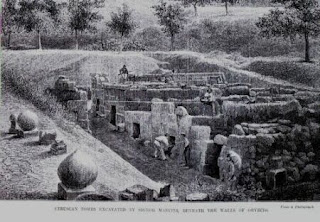Etruria of his times had reverted to a semi-wilderness state, Rural, depopulated, malarial and infested with bandits. There were few roads. In his account he - carefully and meticulously - recorded the monuments he found, and any traditions regarding them.
Excavations at Orvieto, mid-eighteenth century
(G. Dennis , The Cities and Cemeteries of Etruria, vol. II , 40,1878)
Now it's very much different. Most of the sites are excaveted, and the findings - grave goods or whatever valued had emerged from the excavations - are displayed in the many museums existing in Tuscany and Latium, in other parts of Italy and all around the world. But that's not all... Many sites are open, and can be visited without any permission, or without paying any ticket. Whatever has not been excavated yet, but there's any reason to think can yield any findings, is carefully protected against thieves ('tombaroli').
This year I decided to spend my summer holidays in the area of Northern Latium and South Tuscany, visiting the most I can visit in two weeks: the area I'm tring to (very partially...) cover, in the area roughly corresponding to the provinces of Rome, Rieti, Viterbo, Livorno and Grosseto. Having already visited some of the most important museums with collections of antiquities related to the Etruscan civilization - like the National Etruscan Museum of Villa Giulia, in Rome (National Etruscan Museum Villa Giulia), the Etruscan Guarnacci Museum in Volterra (Etruscan Guarnacci Museum), or the Museo Archeologico Nazionale Tarquiniense (Museo Archeologico Nazionale Tarquiniense) - and some important necropolises in northern Latium and Tuscany, this year I opted for a more structured approach to the visits, trying to cover the most I can in this same area. Among the most important cities and necropolises I'm planning to see - either for their museums or for the necropolises - are: Tuscania, Barbarano Romano, with the surrounding Etruscan sites of Blera, San Giuliano and San Giovenale, Valentano, Pitigliano, Vulci, Orvieto, Cerveteri, Pyrgi, Castel d'Asso, ... And this just to mention the very first I'll visit in the first days.
In the next days' posts I'll try to make an account of the visits, at the same time giving some logistics information, hoping to be helpful to anyone planning to have a similar experience. Such a travel needs careful planning: some of the museums and necropolises are in minor centres, sometimes difficult to find (particularly the archaeological sites); the opening times are difficult to ascertain, and morover sometimes multiple websites report contradictory timetables; some museums are normally closed, and only open if you call to reserve a visit; and so on.
After preparing a preliminary schedule, based on the best information available, I personally called all the museums and sites to check they were open, and possibly to reserve visits accompanied. And for some of the sites - more difficult to visit - in order to avoid spending hours to look for a path I reserved full-day support of professional archaeologs to accompany me (me and - by the way - my son, whom I'm trying to involve into this...).
So, let's start the journey with the first stop: Tuscania.
Tuscania as seen from the necropolis 'Madonna dell'Olivo'


Nessun commento:
Posta un commento